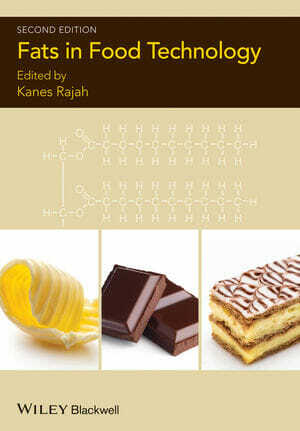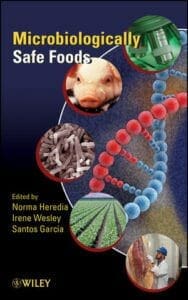List of contributors xi
Preface xiii
1 Physical properties of fats in food 1
Kiyotaka Sato and Satoru Ueno
1.1 Introduction 1
1.2 Basic physical properties of fat crystals 2
1.2.1 Polymorphic structures of fats 2
1.2.2 Polymorphic crystallisation of fats 7
1.2.3 Polymorphic transformation of fats 13
1.2.4 Phase behaviour of fat mixtures 17
1.2.5 Microstructure, texture and rheological properties 20
1.3 Structure–function relations in food fats 22
1.3.1 Fats in bulk phase 22
1.3.2 Fats in oil-in-water emulsions 26
1.3.3 Fats in water-in-oil emulsions 30
1.4 Conclusion 32
References 33
2 Bakery fats 39
Paul Wassell
2.1 Introduction 39
2.2 Production of margarine and shortening 40
2.3 Crystallisation behaviour 42
2.4 Processing 47
2.5 Plastic bakery fats 48
2.5.1 Short pastry 50
2.5.2 Cake 53
2.5.3 Puff pastry 57
2.6 The influence of emulsifiers in baking 60
2.7 Control of quality in margarine and shortening manufacture 62
2.8 Liquid shortenings 65
2.9 Fluid shortenings 66
2.10 Powdered fats, flaked fats and fat powders 67
2.10.1 Methods of manufacture 67
2.10.2 Applications of fat powders and powdered fats 70
2.11 Fat in biscuit baking 72
2.11.1 The function of fats in biscuits 72
2.11.2 Biscuit filling creams 74
2.11.3 Spray fats 75
2.11.4 Fat bloom 76
2.12 Conclusion 76
Acknowledgement 77
References 77
3 Water continuous emulsions 83
H.M. Premlal Ranjith
3.1 Introduction 83
3.1.1 The structure of water continuous emulsions 84
3.1.2 Milk fat globule structure 85
3.2 Preparation of water continuous emulsions 87
3.2.1 Dairy creams 87
3.2.2 Recombined creams 92
3.2.3 Ice-cream mix 95
3.2.4 Heat treatment of emulsions 102
3.2.5 Preparation of dressings 116
3.3 Factors affecting water continuous emulsions 118
3.3.1 Emulsion stability of high-fat creams 120
3.3.2 Defects in ice cream 127
3.3.3 Defects in mayonnaise and salad dressing 130
References 130
4 Oil modification processes 133
Albert J. Dijkstra
4.1 Introduction 133
4.2 Hydrogenation 134
4.2.1 Kinetics and mechanism 135
4.2.2 Industrial hydrogenation processes 139
4.3 Interesterification 144
4.3.1 Chemical catalysis 145
4.3.2 Enzymatic catalysis 149
4.3.3 Interesterification products 151
4.4 Fractionation 151
4.4.1 Fat crystallisation theory 153
4.4.2 Industrial practice 155
4.4.3 Fractionation products 159
4.5 Discussion 161
References 162
5 Fats for chocolate and sugar confectionery 169
Geoff Talbot
5.1 Introduction 169
5.2 Production and properties 170
5.2.1 Cocoa butter and milk fat 170
5.2.2 Symmetrical SOS-type CBAs: cocoa butter equivalents (CBEs) 175
5.2.3 High-trans-type CBAs 178
5.2.4 Low- or zero-trans non-lauric CBAs 180
5.2.5 Lauric-type CBAs 181
5.2.6 Comparison and compatibility 182
5.3 Legislation and regulatory aspects 186
5.3.1 Legislation 186
5.3.2 Adulteration and its detection 189
5.4 Moulded bar and coating applications 191
5.4.1 Chocolate 191
5.4.2 Compound chocolate 192
5.5 Filling applications 195
5.5.1 Fat-based fillings 195
5.5.2 Toffees and other sugar confectionery 198
5.5.3 Truffles 199
5.6 Problem areas 200
5.6.1 Bloom 200
5.6.2 Fat migration 202
5.6.3 Moisture and alcohol migration 204
5.6.4 Rancidity 205
5.7 Nutritional aspects of confectionery fats 206
5.8 Conclusion 207
Acknowledgements 207
References 207
6 Spreadable products 213
Kanes K. Rajah
6.1 Introduction 213
6.1.1 Definition of spreads: margarine, low(er) fat spreads and butter 213
6.1.2 Summary of product development 215
6.1.3 Summary of process development 218
6.1.4 Summary of ingredient development 221
6.1.5 Summary of packaging developments 225
6.2 Legislation 225
6.2.1 EU regulations 226
6.2.2 US regulations 228
6.2.3 Codex standards 228
6.3 Emulsion technology 229
6.3.1 Properties of emulsions 229
6.3.2 Emulsifiers and hydrophilic–lipophilic balance values 232
6.3.3 Stabilisers 233
6.3.4 Preservatives and microbiological stability 233
6.3.5 Emulsion preparation 234
6.4 Process technology 236
6.4.1 Current yellow fat range 236
6.4.2 Scraped-surface cooling 237
6.4.3 Churning technology 244
6.4.4 Storage conditions 246
6.5 Yellow fat blends 247
6.5.1 Trans-fatty-acid-free oil blends 247
6.5.2 Some properties of butter 247
6.5.3 Oils high in lauric and palmitic fatty acids 247
6.5.4 Long-chain fatty acids 249
6.6 Flavoured butters 250
6.7 Non-yellow fat range 250
References 251
7 Emulsifiers and stabilisers 253
Niall W.G. Young
7.1 Introduction 253
7.2 Surface activity 254
7.2.1 Surfactants 254
7.2.2 Surface and interfacial tension 255
7.3 Interface formation 256
7.3.1 Division of internal phase 256
7.3.2 Emulsion formation 257
7.3.3 Foams 258
7.3.4 Wetting 258
7.4 Stabilisation 259
7.4.1 Creaming and sedimentation 260
7.4.2 Flocculation and coalescence 260
7.4.3 Droplet–droplet interactions 261
7.4.4 Viscosity and gelation 262
7.5 Food emulsifiers 263
7.5.1 Monoglycerides 263
7.5.2 Monoglyceride derivatives 263
7.5.3 Polyol esters of fatty acids 266
7.5.4 Lactic acid esters of fatty acids 266
7.5.5 Lecithin 267
7.6 The hydrophilic–lipophilic balance 268
7.7 Hydrocolloid stabilisers and thickeners 270
7.7.1 Hydrocolloids 270
7.7.2 Modified starch 272
7.7.3 Cellulose derivatives 273
7.8 Applications 273
7.8.1 Margarine and dairy products 273
7.8.2 Baking 278
7.8.3 Coatings 280
7.8.4 Dressings and sauces 281
7.9 Regulatory aspects 284
References 284
8 Food safety and quality issues of dairy fats 289
Upuli Wijewardene and H.M. Premlal Ranjith
8.1 Introduction 289
8.1.1 Codex Alimentarius 289
8.1.2 The European Food Safety Authority (EFSA) 290
8.1.3 The importance of the HACCP in food production 290
8.1.4 Food safety standards 291
8.2 Food-borne disease: the problem 291
8.2.1 Microbiology of milk and milk products 291
8.2.2 Magnitude and nature of milk-borne disease outbreaks 292
8.2.3 Food-borne disease outbreak surveillance 293
8.2.4 Surveillance of milk-borne disease outbreaks 294
8.2.5 Control of food-borne diseases 295
8.2.6 Safety of milk and milk products 295
8.3 Food safety and quality issues of dairy fats 296
8.3.1 Approach to risk assessment and the HACCP 297
8.4 Implementing the HACCP 299
8.4.1 Areas concerning food safety 300
8.5 Food safety and quality in dairy production 302
8.5.1 Pasteurised milk 303
8.5.2 Cheese 303
8.5.3 Yogurt 303
8.5.4 Cream/Butter 312
8.6 Future trends 316
References 324
9 Culinary fats: solid and liquid frying oils and speciality oils 327
Mark Farmer
9.1 Introduction 327
9.2 Salad and cooking oils 328
9.3 Frying fats 333
9.3.1 Shallow (pan) frying 333
9.3.2 Deep fat frying 334
9.3.3 Selection of frying media 339
9.4 Oils for roasting nuts 342
9.5 Ghee 343
9.5.1 Ghee attributes and quality 344
9.5.2 Uses of ghee 346
9.6 Vanaspati 346
9.7 Speciality oils 348
9.7.1 Almond oil 349
9.7.2 Groundnut oil 349
9.7.3 Hazelnut oil 351
9.7.4 Sesame seed oil 351
9.7.5 Safflower oil 352
9.7.6 Grapeseed oil 353
9.7.7 Walnut oil 353
9.7.8 Rice bran oil 353
9.7.9 Flaxseed oil 354
9.7.10 Avocado oil 354
9.8 Conclusion 354
References 355
Appendix Nomenclature for fatty acids and triglycerides 359
Index 361















![Ettinger’s Textbook of Veterinary Internal Medicine 9th Edition [PDF+Videos] Ettinger’s Textbook of Veterinary Internal Medicine 9th Edition [True PDF+Videos]](https://www.vet-ebooks.com/wp-content/uploads/2024/10/ettingers-textbook-of-veterinary-internal-medicine-9th-edition-100x70.jpg)

![Textbook of Veterinary Diagnostic Radiology 8th Edition [PDF+Videos+Quizzes] Thrall’s Textbook of Veterinary Diagnostic Radiology, 8th edition PDF](https://www.vet-ebooks.com/wp-content/uploads/2019/09/textbook-of-veterinary-diagnostic-radiology-8th-edition-100x70.jpg)






